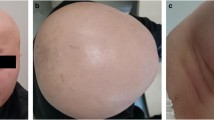Abstract
Autosomal dominant hypophosphatemic rickets (ADHR) is a rare disease, characterized by isolated renal phosphate wasting, hypophosphatemia, and inappropriately normal 1,25-dihydroxyvitamin D3 (calcitriol) levels. This syndrome involves rickets with bone deformities in childhood and osteomalacia, osteoporosis, articular and para-articular pain, and fatigue in adulthood. It is caused by mutations in a consensus sequence for proteolytic cleavage of the FGF23 protein. Normally, this protein actively regulates phosphate homeostasis. Here we report a Tunisian family in which one parent and three children show clinical and biological features of ADHR. Mutation analysis of the FGF23 gene finds a heterozygous substitution of the C at position 526 by a T (526 C → T), leading to an amino acid replacement of the FGF23 protein (R176W) at position 176. This causative new mutation is located in the consensus sequence for the proteolytic cleavage domain. These results confirm the importance of this site in FGF23 function and its essential role in ADHR physiopathology.


Similar content being viewed by others
References
Yu X, White KE (2005) FGF23 and disorders of phosphate homeostasis. Cytokine Growth Factor Rev 16:221–232
Carpenter TO (1997) New perspectives on the biology and treatment of X-linked hypophosphatemic rickets. Pediatr Clin N Am 44:443–466
Laroche M (2001) Phosphate, the renal tubule, and the musculoskeletal system. Joint Bone Spine 68:211–215
ADHR Consortium (2000) Autosomal dominant hypophosphataemic rickets is associated with mutations in FGF23. Nat Genet 26:345–348
Bielesz B, Klaushofer K, Oberbauer R (2004) Renal phosphate loss in hereditary and acquired disorders of bone mineralization. Bone 35:1229–1239
Laroche M, Boyer JF (2005) Phosphate diabetes, tubular phosphate reabsorption and phosphatonins. Joint Bone Spine 72:376–381
Walton RJ, Bijvoet OL (1975) Nomogram for derivation of renal threshold phosphate concentration. Lancet 2:309–310
Bai XY, Miao D, Goltzman D, Karaplis AC (2003) The autosomal dominant hypophosphatemic rickets R176Q mutation in fibroblast growth factor 23 resists proteolytic cleavage and enhances in vivo biological potency. J Biol Chem 278:9843–9849
Econs MJ, McEnery PT (1997) Autosomal dominant hypophosphatemic rickets/osteomalacia: clinical characterization of a novel renal phosphate-wasting disorder. J Clin Endocrinol Metab 82:674–681
Consortium HYP (1995) A gene (PEX) with homologies to endopeptidases is mutated in patients with X-linked hypophosphatemic rickets. Nat Genet 11:130–136
Caruana RJ, Buckalew VM Jr (1988) The syndrome of distal (type 1) renal tubular acidosis. Clinical and laboratory findings in 58 cases. Medicine (Baltim) 67:84–99
Clarke BL, Wynne AG, Wilson DM, Fitzpatrick LA (1995) Osteomalacia associated with adult Fanconi’s syndrome: clinical and diagnostic features. Clin Endocrinol (Oxf) 43:479–490
Econs MJ, McEnery PT, Lennon F, Speer MC (1997) Autosomal dominant hypophosphatemic rickets is linked to chromosome 12p13. J Clin Invest 100:2653–2657
Kaplan FS, Soffer SR, Fallon MD, Haddad JG, Dalinka M, Raffensperger EC (1988) Osteomalacia as a very late manifestation of primary hyperparathyroidism. Clin Orthop Relat Res 228:26–32
Lyles KW, Drezner MK (1982) Parathyroid hormone effects on serum 1, 25-dihydroxyvitamin D levels in patients with X-linked hypophosphatemic rickets: evidence for abnormal 25-hydroxyvitamin D-1-hydroxylase activity. J Clin Endocrinol Metab 54:638–644
Monte Neto JT, Sesso R, Kirsztajn GM, Da Silva LC, De Carvalho AB, Pereira AB (1991) Osteomalacia secondary to renal tubular acidosis in a patient with primary Sjogren’s syndrome. Clin Exp Rheumatol 9:625–627
Polisson RP, Martinez S, Khoury M, Harrell RM, Lyles KW, Friedman N, Harrelson JM, Reisner E, Drezner MK (1985) Calcification of entheses associated with X-linked hypophosphatemic osteomalacia. N Engl J Med 313:1–6
Tieder M, Modai D, Shaked U, Samuel R, Arie R, Halabe A, Maor J, Weissgarten J, Averbukh Z, Cohen N, Edelstein S, Liberman U (1987) “Idiopathic” hypercalciuria and hereditary hypophosphatemic rickets. Two phenotypical expressions of a common genetic defect. N Engl J Med 316:125–129
Benet-Pages A, Lorenz-Depiereux B, Zischka H, White KE, Econs MJ, Strom TM (2004) FGF23 is processed by proprotein convertases but not by PHEX. Bone 35:455–462
Liu S, Guo R, Simpson LG, Xiao ZS, Burnham CE, Quarles LD (2003) Regulation of fibroblastic growth factor 23 expression but not degradation by PHEX. J Biol Chem 278:37419–37426
White KE, Carn G, Lorenz-Depiereux B, Benet-Pages A, Strom TM, Econs MJ (2001) Autosomal-dominant hypophosphatemic rickets (ADHR) mutations stabilize FGF-23. Kidney Int 60:2079–2086
Benet-Pages A, Orlik P, Strom TM, Lorenz-Depiereux B (2005) An FGF23 missense mutation causes familial tumoral calcinosis with hyperphosphatemia. Hum Mol Genet 14:385–390
Larsson T, Davis SI, Garringer HJ, Mooney SD, Draman MS, Cullen MJ, White KE (2005) Fibroblast growth factor-23 mutants causing familial tumoral calcinosis are differentially processed. Endocrinology 146:3883–3891
Salles JP (2006) Genetics of hypophosphosphatemia. Arch Pediatr 13:522–524
Liu S, Vierthaler L, Tang W, Zhou J, Quarles LD (2008) FGFR3 and FGFR4 do not mediate renal effects of FGF23. J Am Soc Nephrol 19:2342–2350
Yamazaki Y, Tamada T, Kasai N, Urakawa I, Aono Y, Hasegawa H, Fujita T, Kuroki R, Yamashita T, Fukumoto S, Shimada T (2008) Anti-FGF23 neutralizing antibodies show the physiological role and structural features of FGF23. J Bone Miner Res 23:1509–1518
Acknowledgments
We are indebted to Sihem Sassi, Ahlem Msakni, and Hedi Laatiri for their excellent technical help.
Author information
Authors and Affiliations
Corresponding author
About this article
Cite this article
Gribaa, M., Younes, M., Bouyacoub, Y. et al. An autosomal dominant hypophosphatemic rickets phenotype in a Tunisian family caused by a new FGF23 missense mutation. J Bone Miner Metab 28, 111–115 (2010). https://doi.org/10.1007/s00774-009-0111-5
Received:
Accepted:
Published:
Issue Date:
DOI: https://doi.org/10.1007/s00774-009-0111-5




